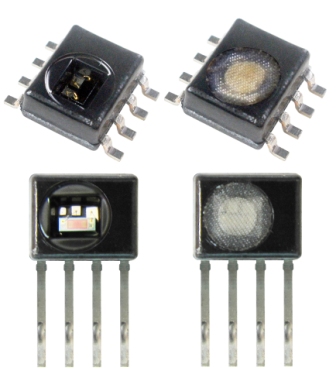Honeywell today announced that new 6000, 7000, 8000, and 9000 Series of the HumidIcon™ combination digital output relative humidity (RH) and thermal sensor solutions are now available.
Primarily targeted for medical, HVAC, and industrial applications, these new sensors offer industry-leading long-term accuracy, stability, and reliability plus true, temperature compensated digital I2C or SPI output. The HumidIcon™ sensors provide a cost effective solution for device and system developers who want to reduce design time and time to market, and also save space on the board.
The Honeywell HumidIcon™ sensor’s proven accuracy eliminates the need for individual test and calibration as there is no part-to-part variation in accuracy, which shortens manufacturing time. Industry-leading, long-term stability helps support system uptime by eliminating the need to service or replace the sensor during its application life, and eliminates the need to regularly recalibrate the sensor in the application, which can be inconvenient and costly. Competitive humidity sensors require a 12 hour at 75 %RH rehydration process (which requires special equipment chambers) to correct reflow temperature offset. Honeywell’s sensor only requires a five-hour rehydration under ambient conditions (>50 %RH).
 New 6000, 7000, 8000, and 9000 Series of the HumidIcon™ combination digital output relative humidity (RH) and thermal sensor solution.
New 6000, 7000, 8000, and 9000 Series of the HumidIcon™ combination digital output relative humidity (RH) and thermal sensor solution.
True, temperature-compensated digital I2C or SPI output allows the customer to remove the components associated with signal conditioning from the PCB to free up space and reduce the costs associated with those components (e.g., acquisition, inventory, assembly). True, temperature-compensated digital I2C or SPI output also often eliminates problems that could occur from having multiple signal conditioning components across the PCB, as well as simplifies integration to the microprocessor, eliminating the need for customer-implemented, complex signal conditioning.
The HumidIcon™ Series (6000, 7000, 8000, and 9000) offers customers the ability to choose housing style (SIP 4-Pin or SOIC-8 SMD), filter (hydrophobic filter or no filter), output (I2C or SPI), and packaging (tape and boxed, tape and reel, or samples on tape). Refer to the HumidIcon™ datasheets for information regarding specifications for each.
“Honeywell’s HumidIcon™ Series delivers the lowest total cost solution due to the sensor’s industry-leading combined humidity/temperature sensor,” said Jacqueline Leff, Honeywell senior global product marketing manager. “It allows the RH measurement to be temperature compensated, and provides a second standalone temperature sensor output allowing the user to purchase one sensor instead of two.”
Honeywell International is a Fortune 100 diversified technology and manufacturing leader, serving customers worldwide with aerospace products and services; control technologies for buildings, homes and industry; turbochargers; and performance materials. Based in Morris Township, N.J., Honeywell's shares are traded on the New York, London, and Chicago Stock Exchanges.
Honeywell Sensing and Control is a leading global supplier of custom-engineered sensors, switches, machine safeguarding and other devices that offer enhanced precision, repeatability and durability to a variety of original equipment manufacturing applications across the medical, industrial, transportation, aerospace, and test and measurement segments.
This release contains “forward-looking statements” within the meaning of Section 21E of the Securities Exchange Act of 1934. All statements, other than statements of fact, that address activities, events or developments that we or our management intend, expect, project, believe or anticipate will or may occur in the future are forward-looking statements. Forward-looking statements are based on management’s assumptions and assessments in light of past experience and trends, current conditions, expected future developments and other relevant factors.
They are not guarantees of future performance, and actual results, developments and business decisions may differ from those envisaged by our forward-looking statements. Our forward-looking statements are also subject to risks and uncertainties, which can affect our performance in both the near- and long-term. We identify the principal risks and uncertainties that affect our performance in our Form 10-K and other filings with the Securities and Exchange Commission.